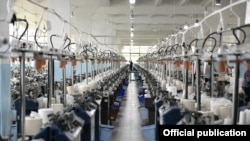The bank forecast a steeper GDP contraction after cutting its benchmark interest rate for the fourth time in six months.
Its governing board lowered the refinancing rate to 4.25 percent, down from 4.5 percent set in June. The minimum cost of borrowing in the country stood at 5.5 percent at the start of the coronavirus pandemic early this year.
In a statement, the Central Bank attributed the latest rate cut to weak consumer demand and a slower-than-expected pace of economic recovery. It said that lingering uncertainty over the length of the pandemic will “considerably restrain and delay” economic rebounds in Russia and other major trading partners of Armenia. The bank is therefore “inclined” to continue softening its monetary policy in the months ahead, added the statement.
“People prefer to save, rather than consume, because there is uncertainty,” Martin Galstian, the Central Bank governor, told a news conference held after the board meeting. “It’s not an Armenian phenomenon. It’s also observed in other countries.”
“Nobody knows when this coronavirus situation will end and what its outcome will be,” he said, according to the Armenpress news agency.
Government data shows the Armenian economy contracting by about 14 percent in the second quarter of this year after growing by almost 4 percent in the first quarter. The decline followed a coronavirus-related nationwide lockdown imposed by the Armenian government in March.
The government gradually reopened most sectors of the economy by the beginning of May. The Central Bank forecast in June a full-year GDP fall of 4 percent. According to its latest revised projections reported by Galstian, 2020 will see a 6.2 percent negative growth rate.
The bank’s statement noted worse-than-expected macroeconomic indicators recorded by Armenia’s Statistical Committee in July.
The government agency registered roughly 10 percent decreases in the volume of construction, trade and other services in the first seven months of this year. By contrast, Armenian industrial output rose by 1.3 percent year on year in the same period.
Prime Minister Nikol Pashinian insisted last week that Armenia has avoided a grave socioeconomic crisis despite the worldwide fallout from the pandemic. Pashinian cited government figures suggesting that unemployment in the country has not increased significantly since March. He also stressed the importance of more than 163 billion drams ($336 million) that has been spent by his government on various stimulus measures.
Opposition figures and other critics of the government have dismissed these measures as insufficient. They remain very critical of the government’s response to the coronavirus crisis and its economic consequences.
Galstian was concerned about continuing delays in the implementation of government-funded infrastructure projects which were expected to mitigate the recession. Still, the Central Bank chief forecast that economic growth in Armenia should resume and reach about 5 percent already next year.
The Armenian economy had expanded robustly since 2017. The government reported a 7.6 percent growth rate last year.





